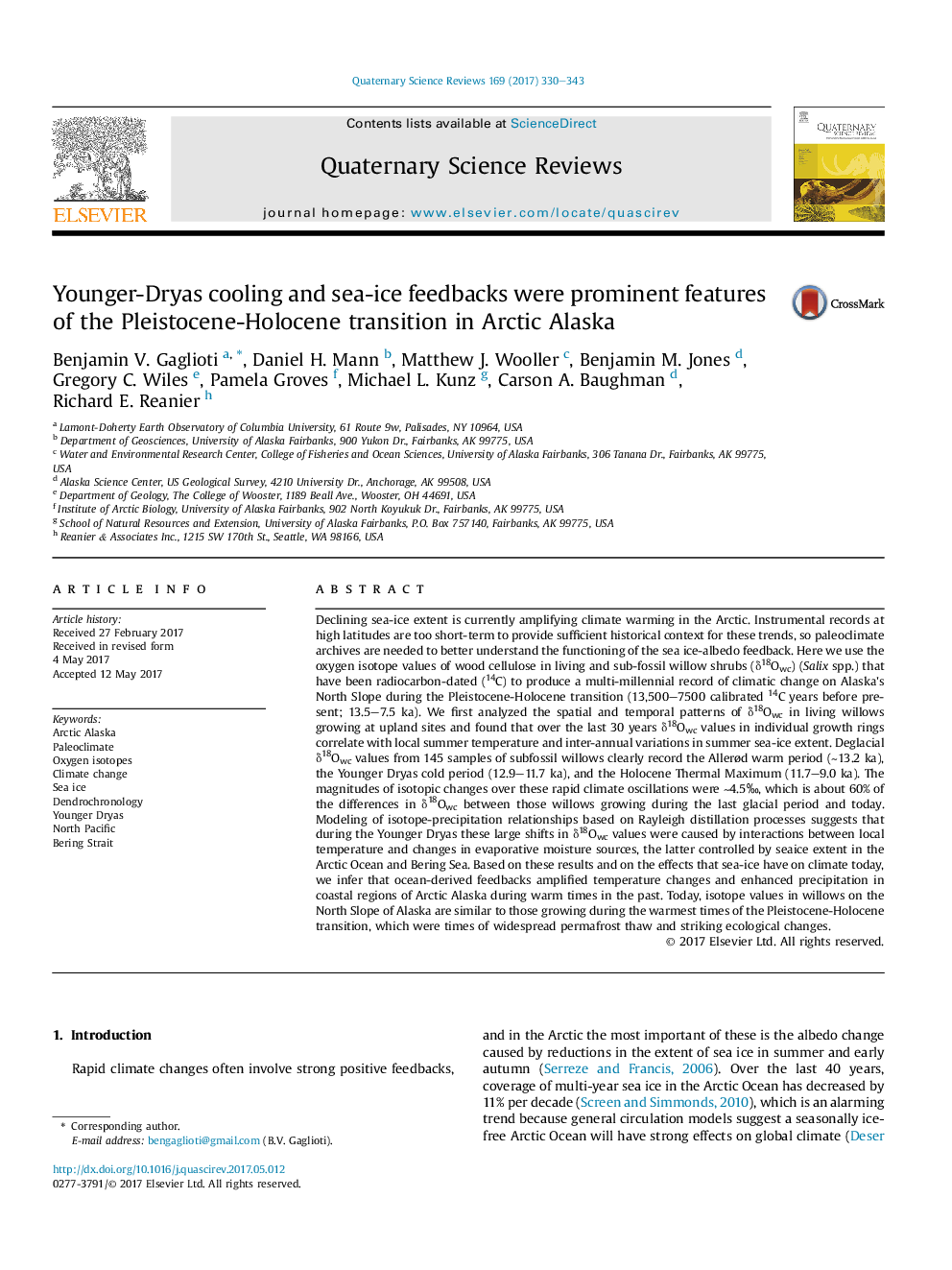| کد مقاله | کد نشریه | سال انتشار | مقاله انگلیسی | نسخه تمام متن |
|---|---|---|---|---|
| 5786658 | 1640766 | 2017 | 14 صفحه PDF | دانلود رایگان |
عنوان انگلیسی مقاله ISI
Younger-Dryas cooling and sea-ice feedbacks were prominent features of the Pleistocene-Holocene transition in Arctic Alaska
دانلود مقاله + سفارش ترجمه
دانلود مقاله ISI انگلیسی
رایگان برای ایرانیان
کلمات کلیدی
موضوعات مرتبط
مهندسی و علوم پایه
علوم زمین و سیارات
زمین شناسی
پیش نمایش صفحه اول مقاله

چکیده انگلیسی
Declining sea-ice extent is currently amplifying climate warming in the Arctic. Instrumental records at high latitudes are too short-term to provide sufficient historical context for these trends, so paleoclimate archives are needed to better understand the functioning of the sea ice-albedo feedback. Here we use the oxygen isotope values of wood cellulose in living and sub-fossil willow shrubs (δ18Owc) (Salix spp.) that have been radiocarbon-dated (14C) to produce a multi-millennial record of climatic change on Alaska's North Slope during the Pleistocene-Holocene transition (13,500-7500 calibrated 14C years before present; 13.5-7.5 ka). We first analyzed the spatial and temporal patterns of δ18Owc in living willows growing at upland sites and found that over the last 30 years δ18Owc values in individual growth rings correlate with local summer temperature and inter-annual variations in summer sea-ice extent. Deglacial δ18Owc values from 145 samples of subfossil willows clearly record the Allerød warm period (â¼13.2 ka), the Younger Dryas cold period (12.9-11.7 ka), and the Holocene Thermal Maximum (11.7-9.0 ka). The magnitudes of isotopic changes over these rapid climate oscillations were â¼4.5â°, which is about 60% of the differences in δ18Owc between those willows growing during the last glacial period and today. Modeling of isotope-precipitation relationships based on Rayleigh distillation processes suggests that during the Younger Dryas these large shifts in δ18Owc values were caused by interactions between local temperature and changes in evaporative moisture sources, the latter controlled by sea ice extent in the Arctic Ocean and Bering Sea. Based on these results and on the effects that sea-ice have on climate today, we infer that ocean-derived feedbacks amplified temperature changes and enhanced precipitation in coastal regions of Arctic Alaska during warm times in the past. Today, isotope values in willows on the North Slope of Alaska are similar to those growing during the warmest times of the Pleistocene-Holocene transition, which were times of widespread permafrost thaw and striking ecological changes.
ناشر
Database: Elsevier - ScienceDirect (ساینس دایرکت)
Journal: Quaternary Science Reviews - Volume 169, 1 August 2017, Pages 330-343
Journal: Quaternary Science Reviews - Volume 169, 1 August 2017, Pages 330-343
نویسندگان
Benjamin V. Gaglioti, Daniel H. Mann, Matthew J. Wooller, Benjamin M. Jones, Gregory C. Wiles, Pamela Groves, Michael L. Kunz, Carson A. Baughman, Richard E. Reanier,